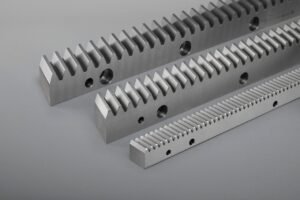In the world of modern manufacturing, the gear rack is a vital component used across various industries including automotive, material handling, construction, and robotics. This blog dives into the intricate processes of gear rack production, offering insights that are both informative and engaging.
What is Gear Rack Production?

Gear rack production involves a series of meticulous steps to create high-precision components essential for the smooth functioning of machinery. Gear racks convert rotational motion into linear motion, making them indispensable in many applications. The process requires a combination of forming, machining, and finishing techniques to achieve the desired accuracy and quality.
Key Steps and Methods in Gear Rack Production Processes
Forming
Forming is the initial stage of gear rack production. It involves several methods to create the basic shape of the gear rack:
- Casting: Molten metal is poured into a mold to form the gear rack. This method is often used for large-scale production.
- Sintering: Powdered metal is compacted and heated to form a solid piece.
- Injection Molding: Plastic or metal is injected into a mold to create the desired shape.
- Extruding: Material is forced through a die to create long, uniform shapes.
- Cold Drawing: Metal is drawn through a die to reduce its diameter and increase strength.
- Stamping: A flat metal strip is shaped using a press.
Performing and Forging
After forming, performing and forging techniques are used to enhance the material properties:
- Performing: The gear rack is subjected to processes like bending and stretching to achieve near-net shapes.
- Forging: Metal is shaped using compressive forces to increase strength and durability.
Machining
Machining is a crucial step in gear rack production, involving roughing and finishing processes:
- Roughing: Initial machining operations remove large amounts of material to approximate the final shape.
- Form Milling: A milling cutter shapes the gear teeth by removing material.
- Rack Generation: Specialized machines generate the gear rack’s teeth with high precision.
- Gear Shaping: A cutter mimics the gear tooth profile to shape the gear.
- Hobbing: A hob cutter generates the gear teeth through a continuous cutting process.
Finishing
Finishing processes ensure the gear rack meets stringent quality standards:
- Shaving: Fine material removal improves surface finish and accuracy.
- Grinding: Abrasive wheels refine the gear teeth to high precision.
- Burnishing: Smoothens the gear teeth surface through rolling.
- Lapping: Two surfaces are rubbed together with an abrasive for a fine finish.
- Honing: Produces a high-precision finish by scrubbing an abrasive stone against the surface.
Generating Method of Producing Gears
The generating method is a sophisticated technique used in gear production. It involves creating the gear profile by moving a cutting tool in a specific pattern relative to the gear blank. This method ensures high precision and consistency in gear production.
Conclusion
Understanding the production processes of gear racks underscores their importance in various industries. From forming and machining to finishing, each step requires precision and expertise. By leveraging advanced techniques and meticulous craftsmanship, manufacturers can produce gear racks that meet the highest standards of quality and performance.

